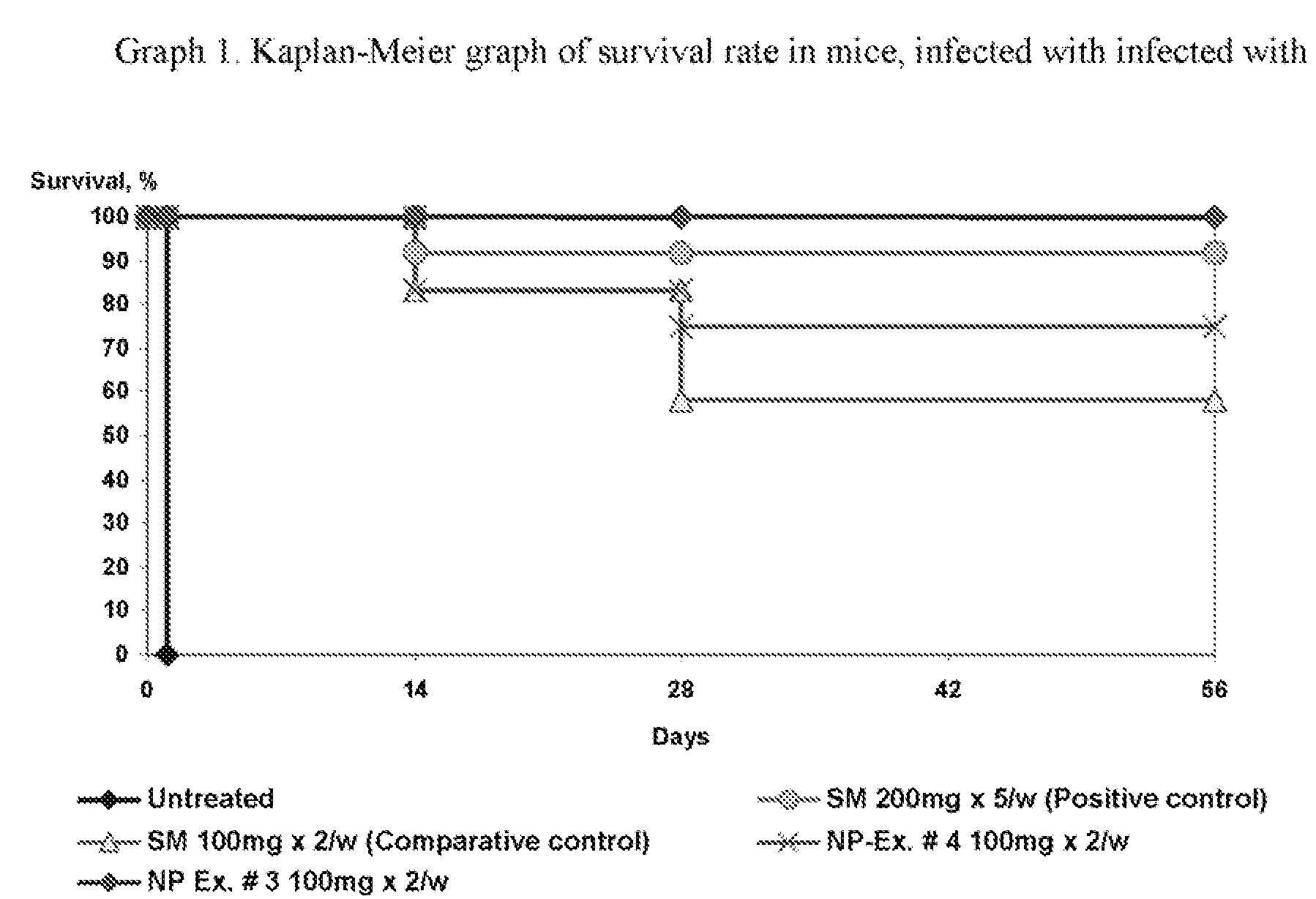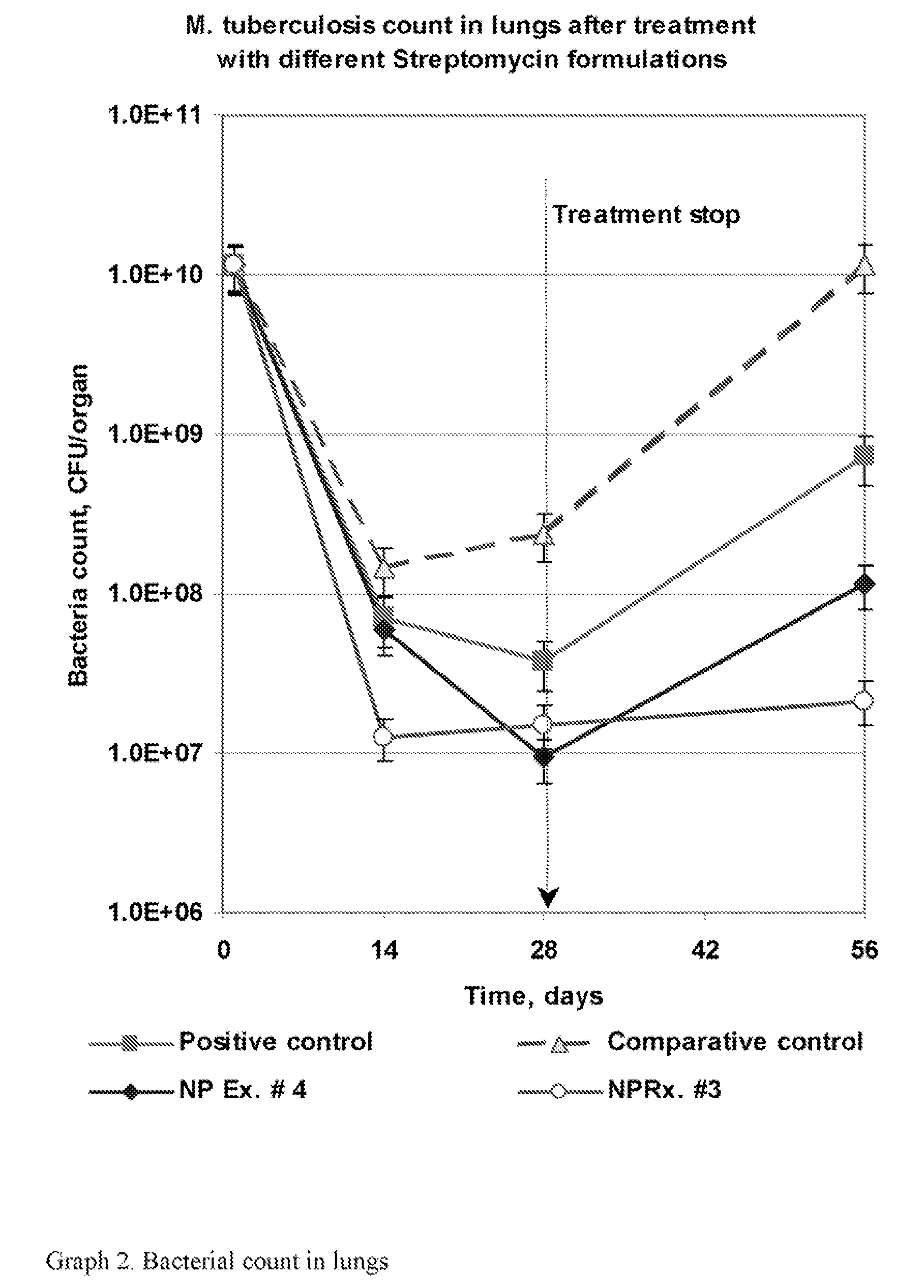Pharmaceutical compositions and use thereof
a technology of pharmaceutical compositions and compositions, applied in the direction of drug compositions, microcapsules, capsule delivery, etc., can solve the problems of less effective treatment of infectious diseases with foci outside the res, e.g., liposomes or submicron emulsions, and non-particulate formulations, so as to improve the binding effect of water soluble antibiotics, improve safety, and reduce side effects
- Summary
- Abstract
- Description
- Claims
- Application Information
AI Technical Summary
Benefits of technology
Problems solved by technology
Method used
Image
Examples
examples 1-9
[0027]50-500 mg of antibiotic (Streptomycin sulfate USP) was dissolved in 0.5-1.0 ml of purified water and emulsified in 5-10 ml of organic solvent (Ethyl Acetate, saturated with water, dry chlorophorm or pure methylene chloride), containing dissolved D,L-lactide-glycolide copolymer (e.g., Resomer® 502, 503 or 503H, Boehringer Ingelheim, Germany), with the help of short sonication (30 sec) at 20 kHz using titanium indenter or a high shear rotor-stator mixer (Ultra-Turrax® T10, IKA, Germany). The formed emulsion was added to a continuous water phase, containing surfactants and may contain other water soluble adjutants, and further homogenized (30 sec sonication, 3-5 cycles of high pressure homogenization (Avestin Emulsiflex® C5 or similar machine). The fine emulsion thus obtained was evaporated under decreased pressure (2-100 mm Hg) to eliminate organic solvents and concentrate the product to a final volume of 10 mL. The final suspension of nanoparticles was centrifugated (10 minutes...
examples 10-15
[0030]Vancomycin loaded polymeric nanoparticles were obtained by a method similar to that described earlier in ex. 1-10. Ethyl acetate was used as an organic solvent, D,L-(poly(lactic)-poly(glycolic) block copolymer Resomer® RG from Boehringer Ingelheim was used as a matrix material of nanoparticles. Drug binding estimation was carried out by transmembrane uitracentrifugation or by sedimentation of the nanoparticles
[0031]by high speed centrifugation. The final volume of the product—10 ml, results are shown
[0032]in Table 2.
TABLE 2Vancomycin loaded polymeric nanoparticlesExample #:101112131415Vancomycin100100100100100100sulfate, mgPolymer502H502H502H502H502S503HPolymer, mg400400400400400400Surfactant(s)Tween 80 2%TweenTweenCremophorTocophersolan 1%Tween 80 2%Lipoid80 2%80 2%EL 2%Lipoid S80 0.5%LipoidS80H 0.5%S80 0.5%Counter-ionTocopherolCholesterolsuccinatesulfateParticle size, nm121182 71131130117Binding19%12%73.3%8.5%15.8%5%
Polymixin B in Biodegradable Polymeric Nanoparticles
examples 16-23
[0033]Polymixin B loaded polymeric nanoparticles were obtained by a method similar to that described earlier in ex. 1-10. Ethyl acetate was used as organic solvent, D,L-(poly(lactic)-poly(glycolic) block copolymer Resomer® RG from Boehringer Ingelheim was used as a matrix material of nanoparticles. Various counter-ions were used to improve drug incorporation into nanoparticles. Drug binding estimation was carried on by transmembrane uitracentrifugation or by sedimentation of the nanoparticles by high speed centrifugation. The final volume of the product—10 ml, results are shown in Table 3.
TABLE 3Polymixin B loaded polymeric nanoparticlesExample #:1617181920212223Polymixin10101010 10252525sulfate, mgPolymer502502502502502S502502503HPolymer, mg200200200200200200200200 Surfactant(s)TweenTweenTweenTweenTweenTweenTweenPluronic80 2%80 2%80 2%80 2%80 2%80 2%80 2%F-68LipoidLipoidS80 0.5%S80 0.5%Counter-ionNaphtyl-Vit. EStearicSodiumVit. EVit. EVit. Esulfonicsuccinateacidcaprylate 0.1%succin...
PUM
 Login to View More
Login to View More Abstract
Description
Claims
Application Information
 Login to View More
Login to View More - R&D
- Intellectual Property
- Life Sciences
- Materials
- Tech Scout
- Unparalleled Data Quality
- Higher Quality Content
- 60% Fewer Hallucinations
Browse by: Latest US Patents, China's latest patents, Technical Efficacy Thesaurus, Application Domain, Technology Topic, Popular Technical Reports.
© 2025 PatSnap. All rights reserved.Legal|Privacy policy|Modern Slavery Act Transparency Statement|Sitemap|About US| Contact US: help@patsnap.com



